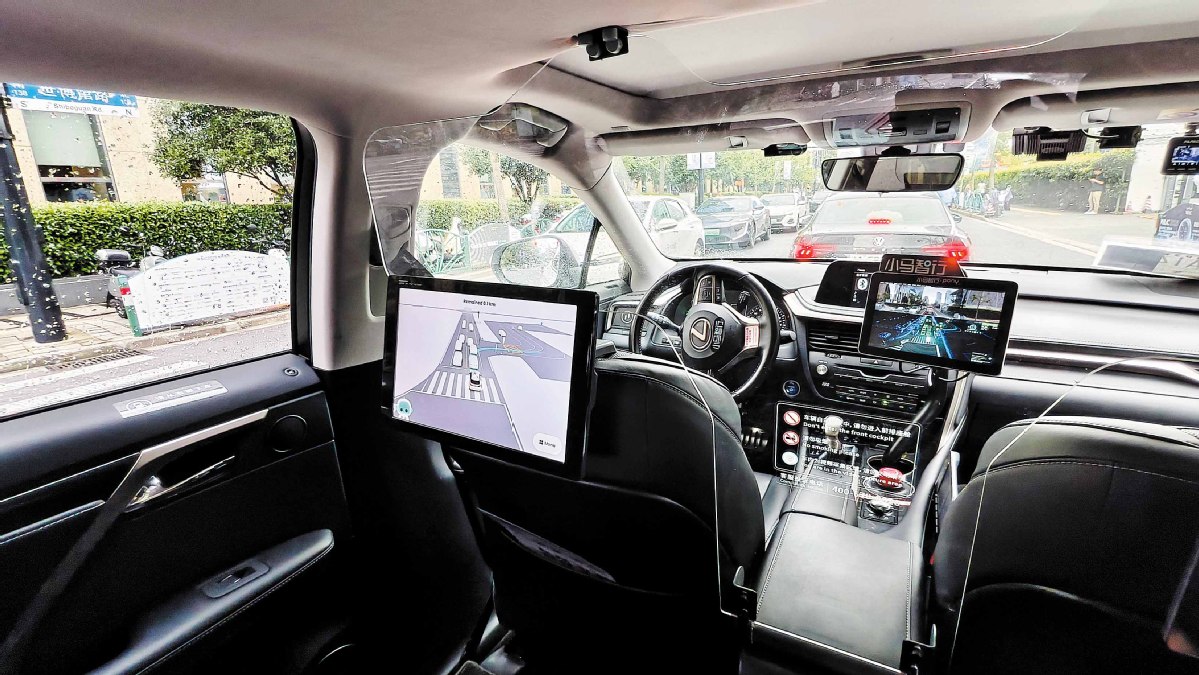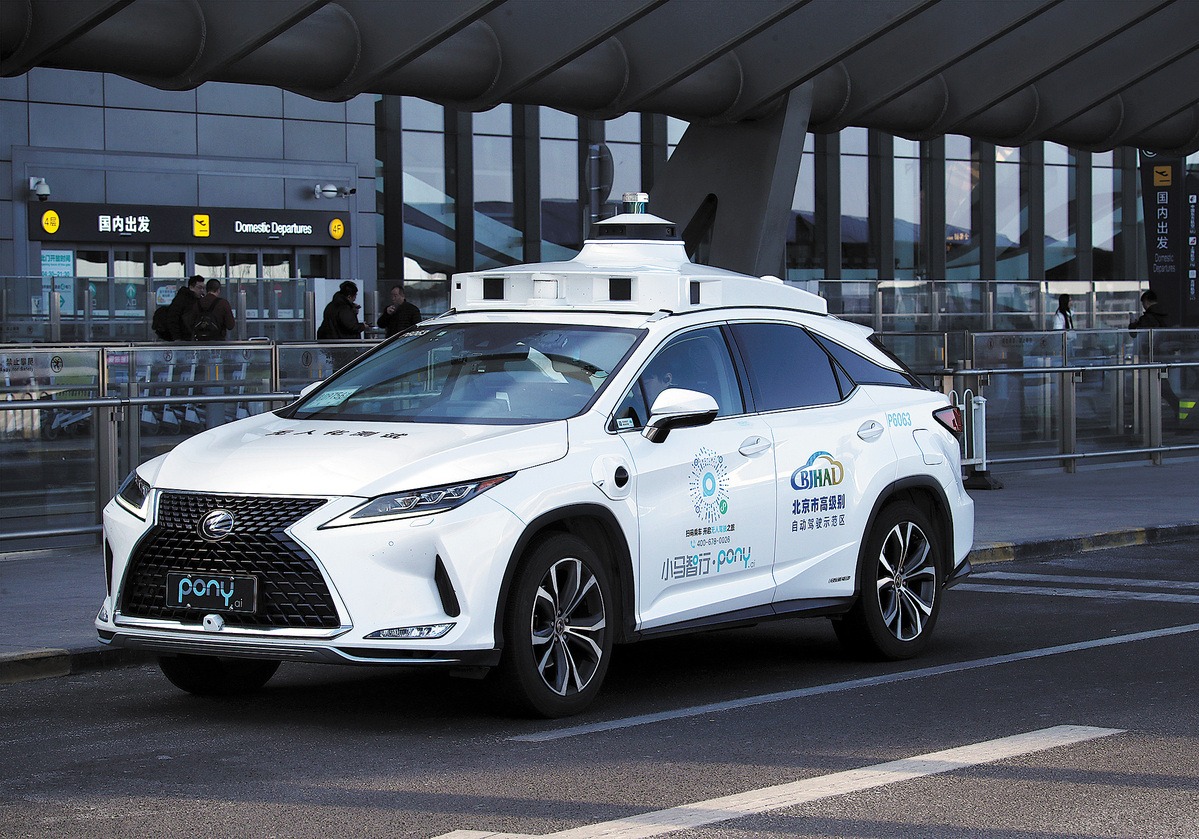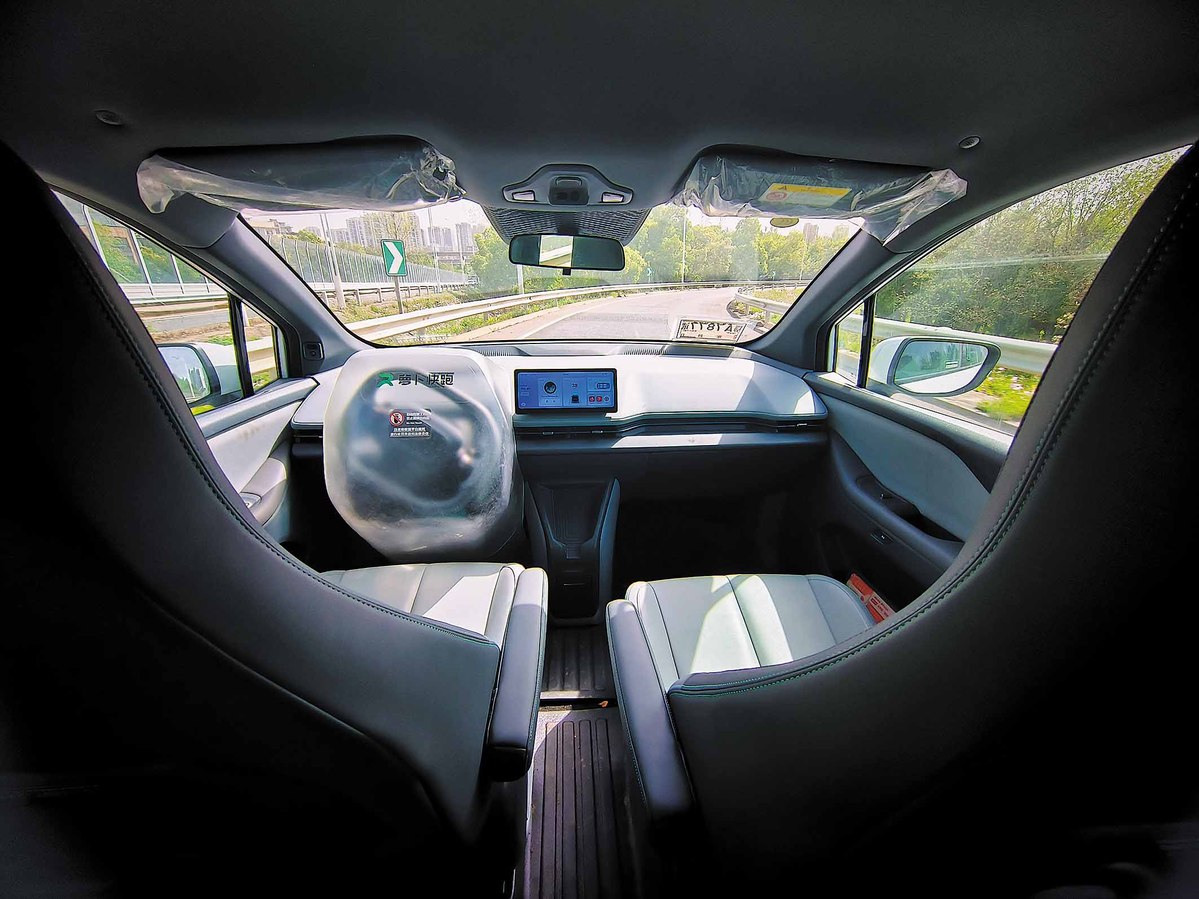今日上海
上海“模式”引领自动驾驶出租车服务发展 - 2025年09月10日
Shanghai 'model' sets pace for robotaxi services
 A self-driving car in Shanghai during the World Artificial Intelligence Conference in Shanghai on July 28.
A self-driving car in Shanghai during the World Artificial Intelligence Conference in Shanghai on July 28. Shanghai teenager Tang Yuyang paid 21 yuan ($2.95) to ride 5.8 kilometers in a robotaxi for the simple joy of becoming a small part of the city's automotive history.
On the morning of Aug 1, he booked a robotaxi ride at the entrance of Century Park, located within the designated operation zone of one of the commercial driverless taxi pilot services in Pudong New Area. Tang was one of the first passengers of the new service offered in Shanghai by the autonomous mobility service provider Pony.ai.
The 16-year-old high school student described the trip as smooth, comfortable and safe, and "close to riding with a human driver, but with a touch of technology".
"When the car arrived after a short wait, many elderly residents nearby stopped to watch with curiosity," he said.
"I felt a little nervous when I got in, but mostly I was excited."
Shanghai has joined Beijing and several other Chinese cities in offering commercial robotaxi services. But what sets the city's services apart is that they are operating in business areas with heavy populations.
As part of the approvals granted for autonomous ride-hailing services in Shanghai, operators must team with traditional taxi companies to tap into their knowledge and experience.
Pony.ai is among eight companies recently licensed to launch driverless commercial robotaxi services in the city.
It has partnered with Jin Jiang International Holdings Co's taxi service arm to launch a regular robotaxi service in Shanghai's Jinqiao and Huamu areas. Operating Monday to Friday from 7:30 am to 9:30 pm, the routes cover key destinations such as the Pudong New Area government, Lalaport shopping mall, Century Park, and the Pudong Football Stadium metro station, linking workplaces, residential areas, and recreational spots.
"Since the pilot service began on Aug 1, the robotaxis have been running at near full capacity, operating more than 10 hours a day with rides in high demand," said Shi Deming, deputy general manager of Jin Jiang's taxi service arm.
The service area was chosen to match city traffic conditions and the requirements of the pilot program, Shi said. With its high population and commercial density, the district offers a good representative environment for testing different scenarios, he added.
"Our long-term goal extends beyond this pilot phase; we are preparing for large-scale commercial deployment, aiming to drive the transformation and upgrading of traditional taxi operations through new quality productive forces," Shi said.
Huang Jun, vice-president of Pony.ai, said: "The Jinqiao and Huamu areas were chosen as the starting point for driverless taxi services because they combine office buildings, upscale residences, and retail facilities, forming a complete urban community with diverse use scenarios."
According to Huang, the selected area also has heavy foot traffic and strong demand for transportation, making it an ideal place to test the service in real-world conditions.
"Looking ahead, we plan to gradually expand the network across Pudong, increase the size of the autonomous fleet, and add more pickup points so more residents can experience robotaxi travel," he said.

A Pony.ai self-driving taxi arrives at Beijing Daxing International Airport on Feb 25.
Rise of new tech
Shanghai issued its first eight demonstration operation permits for intelligent connected vehicles on July 26 during the 2025 World AI Conference& High-level Meeting on Global AI Governance.
Apart from Pony.ai and Jin Jiang taxi, the recipients included SAIC AI Lab, Utopilot, Baidu Inc's autonomous ride-hailing platform Apollo Go, Shanghai Qiangsheng Holding Co, and Dazhong Transportation Group Co.
On Aug 15, Qiangsheng Taxi and SAIC AI Lab launched their joint intelligent connected vehicle service in the Lin-gang Special Area, now operating as a commercial service.
The service has 58 designated pickup and drop-off points across Lin-gang Special Area, and reaches key locations such as tourist attractions, commercial centers, residential neighborhoods, and public transit hubs. It operates between the peak travel periods of 8 am and 8 pm.
On the same day, Dazhong Transportation Group and Apollo Go jointly launched a driverless vehicle pilot test in the Jinqiao area.
Ge Lei, general manager of marketing with Dazhong's taxi arm, said the fleet includes five fifth-generation Apollo Go vehicles operating without in-vehicle safety operators.
The service runs on weekdays from 9 am to 6 pm, covering an area of about 25 square kilometers, with plans to expand to nearby areas, Ge said. Rides can be booked via the Apollo Go app's mini-program, or through Dazhong's app.
Unlike regular ride-hailing services, passengers must board and alight at designated stops. About 70 such stations are currently in operation in Jinqiao, with more to be added as the service grows.
In April 2023, Dazhong and Apollo Go were given one of Shanghai's first permits for intelligent connected taxis in Jiading district, and conducted test rides with safety drivers onboard. "The experience gained there laid the groundwork for this fully driverless trial in Jinqiao," Ge said.
On Aug 20, IM Motors and SAIC AI Lab jointly launched a driverless robotaxi service linking Shanghai Disney Resort and Shanghai Pudong International Airport.
The service also offers short-distance connections between popular spots within the Shanghai International Resort area, reported the Shanghai Observer news portal. The spots include two hotels at Shanghai Disney Resort and train stations on the Airport Link Line.

A Radish Run robotaxi drives in a street of Wuhan, Hubei province, on March 20.
The Shanghai model
Unlike other Chinese cities piloting robotaxis, Shanghai requires autonomous driving companies to partner with traditional taxi operators to run services jointly.
"This model draws on the strengths of both sides and offers opportunities for conventional taxi operators to make a transition by minimizing risks," Ge said.
While tech firms focus on self-driving systems, taxi companies bring operational experience, from handling unexpected traffic incidents to ensuring service quality. They also manage tasks such as vehicle cleaning, maintenance, inspections, and charging of new energy vehicles — all crucial for the passenger experience, Ge said.
"As a familiar brand, Dazhong also provides greater public recognition and trust. We formed a strategic partnership with Baidu in October 2022 and secured one of Shanghai's first demonstration permits in April 2023," he said.
"There are three phases throughout the robotaxi development procedure both for vehicles with and without safety operators, namely road testing without passengers, trial rides with safety drivers, and the third stage of paid pilot operations," Ge added.
Fang Yinliang, a partner with consultancy McKinsey, said: "Shanghai's model may be the closest yet to a truly market-ready and commercialized approach for robotaxis. The service is seen as a complex ecosystem that involves technology firms, automakers, and operators — each with different strengths."
Automakers excel at vehicle production and hardware integration, but they often lack the agility to quickly update software or manage daily operations, Fang said.
Tech companies, on the other hand, bring innovation by using big data and algorithms to improve efficiency. However, they are less experienced in hardware manufacturing or managing vehicles and customer services, he said.
"By combining their strengths, the companies can complement each other, identify risks more effectively, and continuously refine both technology and operations," Fang added.
This ecosystem model is not only practical but also essential for robotaxis to reach large-scale deployment, experts said.

A passenger tries ride-hailing commercial service of a robotaxi in Shanghai.
Years of preparation
As the Chinese saying goes, "constant dripping wears away the stone". The recent rollout of autonomous driving projects in Shanghai is the result of years of preparation.
Huang, vice-president of Pony.ai, said the company began exploring new ways to integrate self-driving technology into traditional taxis in 2022, partnering with Jin Jiang taxi.
In 2023, the two companies jointly received demonstration permits from the city and launched a pilot autonomous taxi service in Jiading district.
Shi, from Jin Jiang's taxi service arm, said: "Over the years, we have explored various cooperation models with partners. The autonomous vehicle sector is still in its early stages. While many companies may enter the race, only a few are likely to remain long-term."
Dazhong Transportation's Ge said the company first entered the autonomous driving field in 2021, exploring partnerships with several tech firms, including Baidu.
"Eventually, we established a deeper collaboration with Baidu, signing a strategic cooperation agreement in October 2022 after both sides confirmed mutual alignment," he said.
In the past two years, autonomous and intelligent driving technologies have advanced rapidly, and experts believe the industry is approaching a key takeoff point.
"Apart from the technology leap, the rise of new-energy and smart vehicles has boosted consumer awareness of intelligent mobility in China, which means on the demand side, people increasingly believe that technology can deliver real convenience," said Fang from McKinsey.
Fang said the intelligent mobility sector is a large ecosystem involving hardware firms, tech companies, automakers, and operators. Years of industry development have strengthened each player's capabilities, creating the conditions to accelerate the sector's growth.
Nationwide expansion
Derek Hong is a 32-year-old compliance chief at a multinational crypto assets company in Hong Kong.
On Aug 15, he experienced a 10-km robotaxi ride provided by Pony.ai during a business visit to Nansha district in Guangzhou, Guangdong province.
"The whole ride was smooth and steady. You hardly noticed it (the vehicle) was driverless," Hong said. "The in-car screen clearly detected motorcycles, pedestrians, and bicycles. It felt impressive."
He added he had heard about robotaxi trials in a closed area of Hong Kong's New Territories and was eager to try them if given the chance.
Robotaxi services have already expanded across multiple cities in China. Pony.ai, for example, launched the country's first autonomous ride service in Guangzhou in December 2018, initially with safety operators and free rides. In May 2020, the service started in Beijing, followed by Shanghai in July 2021 and Shenzhen in May 2022.
By the second half of 2023, fully driverless commercial operations began in several cities.
In August 2023, fully autonomous rides offered by Pony.ai were approved in Beijing. In December 2023, Nansha district approved the first driverless commercial mixed-traffic trial; in January 2024, Shenzhen's Bao'an district granted a commercial pilot license; and by July 2025, Shanghai issued its first demonstration permit for intelligent connected vehicles.
In a May report on China's robotaxi market, Goldman Sachs estimated the country's Robotaxi TAM (Total Addressable Market) would reach $47 billion by 2035 versus $54 million in 2025, with the driving forces including decreasing costs of hardware and algorithms, and lower operating costs for fleet owners.
"By 2035, we expect revenues per robotaxi in first-tier cities to reach $31,000, higher than current ride-hailing vehicles, due to longer operating hours and efficient route planning," said the report.
Fang said China's robotaxi development is likely leading the world, and has benefited from advances in smart and electric vehicles. Autonomous driving relies on deep-learning AI, and China's vast and diverse market — with varied scenarios and regions — provides a rich environment for training and refining algorithms, which makes the country particularly well-suited for accelerating autonomous driving technology.
"From a safety perspective, autonomous vehicles have a relatively low accident rate. Unlike human drivers, who can experience fatigue or be in a bad mood, self-driving systems remain consistent," said Shi.
Insurance data from the latest coverage for driverless vehicles also reflects confidence in the technology, with premiums lower than those for traditional cars, he said.
"From a business standpoint, full automation could reduce labor costs in the future. While the technology may temporarily affect drivers in the industry, it is also expected to create new roles, such as back-end monitoring staff and safety operators," Shi added.
Source: China Daily
